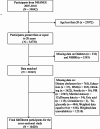The association between non-high-density lipoprotein cholesterol to high-density lipoprotein cholesterol ratio with type 2 diabetes mellitus: recent findings from NHANES 2007-2018
- PMID: 38773578
- PMCID: PMC11106869
- DOI: 10.1186/s12944-024-02143-8
The association between non-high-density lipoprotein cholesterol to high-density lipoprotein cholesterol ratio with type 2 diabetes mellitus: recent findings from NHANES 2007-2018
Abstract
Objective: This study aims to assess the relationship between NHHR (non-high-density lipoprotein cholesterol to high-density lipoprotein cholesterol ratio) and Type 2 diabetes mellitus (T2DM) in US adults, using National Health and Nutrition Examination Survey (NHANES) data from 2007 to 2018.
Methods: This study explored the connection between NHHR and T2DM by analyzing a sample reflecting the adult population of the United States (n = 10,420; NHANES 2007-2018). NHHR was characterized as the ratio of non-high-density lipoprotein cholesterol to high-density lipoprotein cholesterol. T2DM was defined based on clinical guidelines. This research used multivariable logistic models to examine the connection between NHHR and T2DM. Additionally, it included subgroup and interaction analyses to assess variations among different groups. Generalized additive models, smooth curve fitting, and threshold effect analysis were also employed to analyze the data further.
Results: The study included 10,420 subjects, with 2160 diagnosed with T2DM and 8260 without. The weighted multivariate logistic regression model indicated an 8% higher probability of T2DM for each unit increase in NHHR (OR: 1.08, 95% CI: 1.01-1.15) after accounting for all covariates. Subgroup analysis outcomes were uniform across various categories, demonstrating a significant positive relationship between NHHR and T2DM. Interaction tests showed that the positive link between NHHR and T2DM remained consistent regardless of age, body mass index, smoking status, moderate recreational activities, hypertension, or stroke history, with all interaction P-values exceeding 0.05. However, participants' sex appeared to affect the magnitude of the connection between NHHR and T2DM (interaction P-value < 0.05). Also, a nonlinear association between NHHR and T2DM was discovered, featuring an inflection point at 1.50.
Conclusions: Our study suggests that an increase in NHHR may be correlated with a heightened likelihood of developing T2DM. Consequently, NHHR could potentially serve as a marker for estimating the probability of T2DM development.
Keywords: Cross-sectional study; NHANES; NHHR; Type 2 diabetes mellitus.
© 2024. The Author(s).
Conflict of interest statement
The authors declare no competing interests.
Figures
References
-
- Jwad SM, Al-Fatlawi HY. Types of diabetes and their effect on the immune system[J] J Adv Pharm Pract. 2022;4:21–30.
-
- Smokovski I. Managing diabetes in low income countries[M]. springer; 2021.
MeSH terms
LinkOut - more resources
Full Text Sources
Medical



